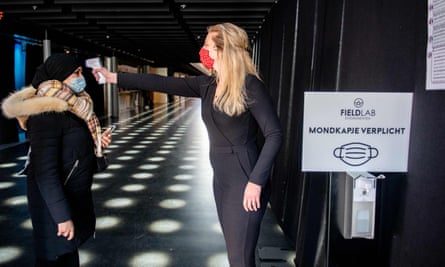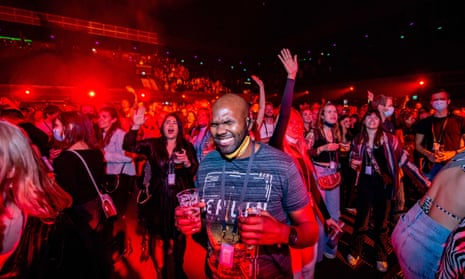It wasn’t quite one of the great carefree, hedonistic nights of the past, but clubbers in Amsterdam were given a short reprieve from lockdown at the weekend as part of an examination of the risks attached to getting people back on the dancefloor.
The Ziggo Dome, the largest music arena in the Dutch capital, was opened to 1,300 people for four hours on Saturday. They were encouraged to dance to sets by Dutch DJs Sam Feldt, Lady Bee and Sunnery James & Ryan Marciano.
Those participating were traced in all their movements and contacts through a tag, as part of an effort to examine how events may safely be opened up for the public again. They had been divided into five “bubbles” of 250 people, plus one of 50, each of which had to comply with different rules.
Some were constrained in their movement on the dancefloor, while others were variously asked to wear a mask at all times or only when in motion. One group was given a fluorescent drink and encouraged to sing and scream to the music in order to examine how much saliva was released at moments of peak revelry.
Government advisers will use the data they collect on the behaviour recorded to help make decisions on possibly easing the restrictions on night life in the coming months. One of the observations, organisers said, was that even those asked to keep their masks on soon dispensed with them as they got into the flow of the music.

Tim Boersma, of Fieldlab, the organisation carrying out the research for the government, said: “We hope this can lead to a tailor-made reopening of venues. Measures are now generic, allowing for instance a maximum of 100 guests at any event if coronavirus infections drop to a certain level. We hope for more specific measures, such as allowing the Ziggo Dome to open at half its capacity.”
The Ziggo Dome has a normal capacity of 17,000 but 100,000 applied for 1,350 €15 (£13) tickets. They sold out in 20 minutes.
Everyone attending had to have received a negative test for coronavirus 48 hours before the event. Twelve applicants had received a positive test result before the event and were barred from taking part. Those who did attend were asked to take another test five days afterwards.
Feldt, 27, who has not performed to a large audience since his tour to the US was cancelled last March, said the event had given him hope. “I see light at the end of the tunnel again,” he said. “We have now been in it for about a year together and with the vaccinations, the testing possibilities and these kind of test events, I think there are a lot of signs that we will hopefully see some more parties in the summer.”

The gig was part of a series of government-backed research events that have also included a business conference of 500 people, a performance in front of a similar number of people by cabaret artist Guido Weijers, and a football match involving 1,200 cheering supporters. Two open-air festivals in Biddinghuizen have also been planned, as well as a pop concert.
It is more than a year since gatherings of more than 100 people were banned in the Netherlands. All bars and restaurants in the country have been closed since mid-October. A nationwide 9pm to 4.30am curfew has been in place for the past six weeks. The event at the Ziggo Dome ran from 3pm to 7pm in order to be compliant.
Natasja de Rooij, 29, from Utrecht, who attended with her boyfriend, Stefan, said it was “very nice to get away from it all after all that sitting at home”. “And we are also doing something good,” she said. “Stefan and I were actually supposed to get married last summer. Maybe it can still be done this summer.”
The bubbles
Bubble 1 People were told to wear a mask all the time. They could decide for themselves where to stand, but had to ensure that there were no more than three people in a square metre of space.
Bubble 2 People wore a mask all the time and were told to keep a distance of 1.5 metres.
Bubble 3 People wore a mouth mask only when in motion and had to stand on designated spots.
Bubble 4 People wore masks all the time. There were seats available.
Bubble 5 People only masks only when on the move. There were standing and seating areas. The participants were put in their dancing spot by the organisers with two chairs spacing people apart.
Bubble 6 No masks. People were allowed to stand or sit where and when they pleased.









